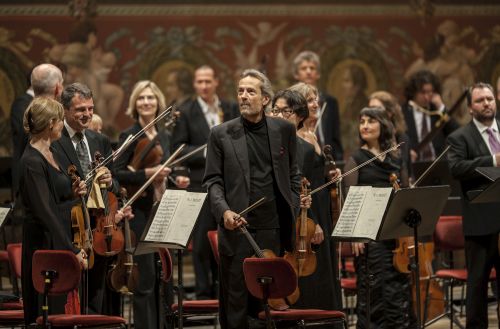Dresden Music Festival 2014
 Germany Beethoven: Camilla Nylund (soprano), Elisabeth Kulman (mezzo-soprano), Richard Croft (tenor) & Yorck Felix Speer (bass), Balthasar-Neumann-Chor, Dresdner Festspielorchester/Ivor Bolton (conductor), Semperoper, Dresden, 8.6.2014.
Germany Beethoven: Camilla Nylund (soprano), Elisabeth Kulman (mezzo-soprano), Richard Croft (tenor) & Yorck Felix Speer (bass), Balthasar-Neumann-Chor, Dresdner Festspielorchester/Ivor Bolton (conductor), Semperoper, Dresden, 8.6.2014.

Beethoven: Missa solemnis, Op. 123
At last year’s Dresden Music Festival I attended a concert of Baroque music by the Dresdner Festspielorchester under Ivor Bolton at the Albertinum. For this festival concert Ivor Bolton’s orchestra had joined forces with four excellent soloists and the Balthasar-Neumann-Chor and had moved forwardto the late Classical/early Romantic era for a performance of the Beethoven Missa solemnis at the Semperoper.
The inspiration behind the Missa solemnis was the installation in 1819 of Beethoven’s most valued patron Archbishop Rudolph, the youngest son of Emperor Leopold II and youngest brother of Emperor Franz. Beethoven invested considerable time as well as emotional and spiritual energy on his Missa solemnis and didn’t complete the immense sacred work until 1823 some three years after Rudolph’s enthronement as the Cardinal-Archbishop of Olmütz. Already in 1807 Beethoven had composed a mass – a commission from Prince Nicholas Esterházy for the name day of his wife.
The Semperoper has a marvellous acoustic when set up for orchestral and choral concerts and was an ideal platform for the Missa solemnis. Ivor Bolton’s Dresdner Festspielorchester is a period instrument ensemble drawing players who specialise in historical performance practice from a number of Europe’s early music groups.So there were plenty of gut strings, period bows and cellos without spikes held by the pressure of the calves and knees. Some players didn’t take the authentic concept too stringently as a number of the violins and violas had modern set-ups and I saw some use of vibrato. I am a long-time enthusiast of period instrument performances of Baroque and Classical music; however, in my opinion the Beethoven Missa solemnis often sounds better on modern instruments. In addition the searing heat in Dresden and the intense humidity inside the Semperoper seemed to adversely affect the tuning of the strings. I recall the leader’s solo in the Sanctus was beset with intonation problems. The playing of the Dresdner Festspielorchester was enthusiastic and at times capable of producing a captivating effect but too often the playing was lacking in the level of unity required at this level and far too often untidy playing marred the overall product.
Bolton’s quartet of soloists were impressive, especially the striking and classy soprano of Camilla Nylund delivering such power and clarity of expression. One sensed she was desperately trying to keep her operatic sensibilities under wraps and concentrate on the reverential aspect of the text. Singing well enough the voice of mezzo-soprano Elisabeth Kulman carried satisfactorily and demonstrated her clear and precise enunciation. I admired the voice of tenor Richard Croft, bright and fairly piercing at times yet almost always appealing on the ear and so respectful of the sacred text. The deep, resonant bass of Yorck Felix Speer sounded reverential yet his voice didn’t carry too well through the hall and his endings almost always faded away. Consistently impressive all evening the Balthasar-Neumann-Chor deserve real praise and come across as a talented and well drilled ensemble.
Highlights for me were the uninhibited outburst of praise of the Gloria which had volume and was loaded with sacred awe. I especially enjoyed the singing of Quoniam tu solus sanctus which sounded marvellously dramatic. In the Sanctus which opens stealthily the remarkable soprano Camilla Nylund gave her all and in the conclusion to the Agnus Dei the Dona nobis pacem with the soloists standing to sing with the chorus the effect was stunning.

During my time in Dresden this festival I have seen a number of quite impeccably dressed orchestras but I couldn’t include the Dresdner Festspielorchester amongst them. I felt the presentation of the orchestra could have been greatly improved if the clothing worn by the orchestra players had been uniformly black and white. Two or three of the women looked out of place wearing sparkly and coloured tops and the men wore a mixed bag of darkish lounge suites and formal wear including an array of coloured ties. Overall I enjoyed hearing the Beethoven Missa solemnis at the Semperoper played on period instruments but it could have been significantly improved. In truth under Ivor Bolton direction there was never a convincing feel of hearing a cohesive unit.
Michael Cookson
